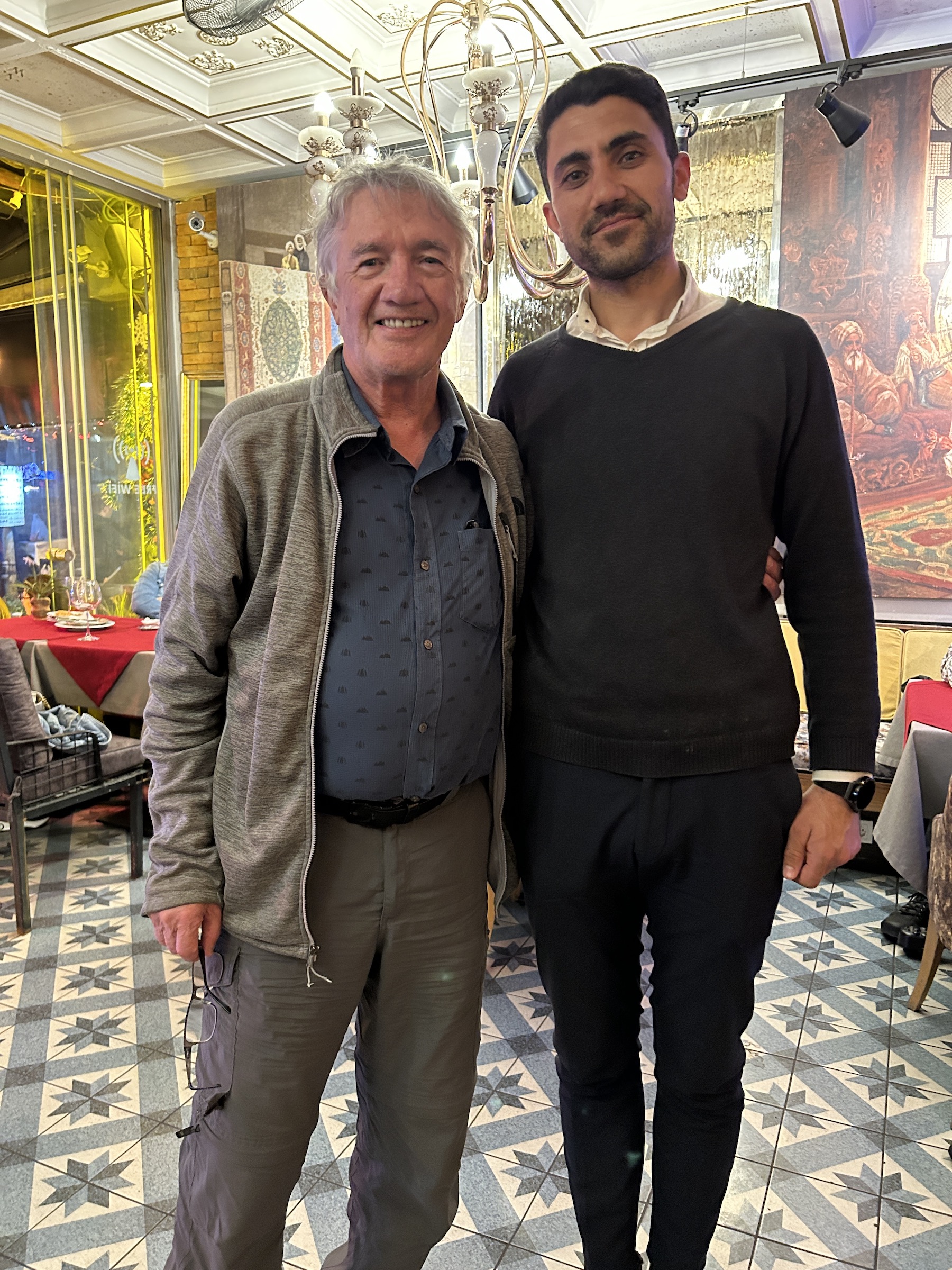Hagia Sophia – Church, Mosque or Museum?
In the last two posts we finally got the Adventures Abroad tour of western Turkey underway with a bus tour of the Golden Horn and a walking tour of the Sultanhamet. We concluded the walking tour post at the Baths of Roxelana, but only because Hagia Sophia is worthy of its own recognition. Please join us as we visit what is arguably the most important church in Christendom even though it’s now a mosque. After that we’ll conclude our tour of the Sultanhamet with a visit to the Cistern of Philoxenos aka The 1001 Columns.
History of Hagia Sophia
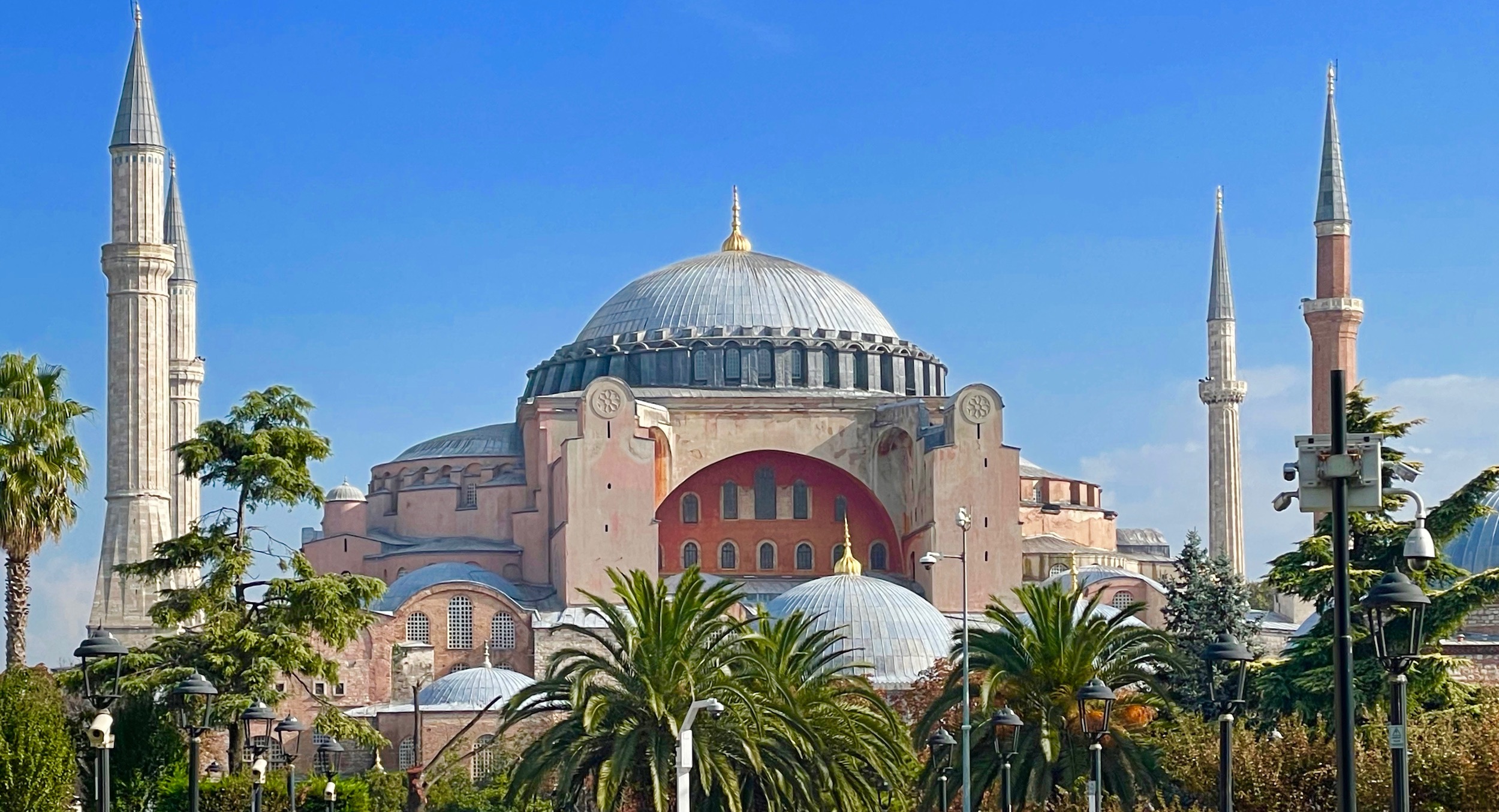
I am willing to bet that Hagia Sophia is the most recognizable piece of Christian architecture in existence and that’s largely because it doesn’t look like what we expect a church to look like. In fact it looks like a giant mosque, which it actually is, but more on that later. The irony is that what we think of as the shape of a typical mosque is based upon Hagia Sophia and not the other way around. In fact, when Hagia Sophia was built Islam did not even exist. It was already a thousand years old when Suleiman’s architect Mimar Sinan used it as the archetype for the Mosque of Suleiman and many others he designed.
Of all the eastern Roman Emperors, Justinian is by far the most well known after Constantine and there’s a good reason for that. Reigning from 527 to 565 he in essence presided over the rebirth of the Roman Empire as an entity ruled from Constantinople and not Rome. He expanded the boundaries of the empire greatly, retaking many of the lands lost by the now defunct western Roman Empire, including Rome itself. He instituted a revised code of Roman law that remains in effect in many places today He is often referred to as ‘The Last Roman’ because when he died the Roman Empire had been transformed into the Byzantine Empire which would last for almost another 900 years. And there is no symbol more responsible for that transition than Hagia Sophia which is considered the greatest piece of Byzantine architecture in the world.
The Hagia Sophia we are visiting today with our guide Yasemin Reis is actually the third version to stand on this hallowed ground. The first church was built by Constantius II in 360 and replaced by one built by Theodosius II in 415; he’s the same guy who built the fortified walls of Constantinople portions of which still stand today. There’s no reason to think Theodosius’ church would not have survived but for the infamous Nika Riots which broke out in 532 just five years after Justinian took the throne. Over half the city was burnt to the ground including the Church of Theodosius. There are still some remnants of this church that Yasemin pointed out including this lintel with six lambs.
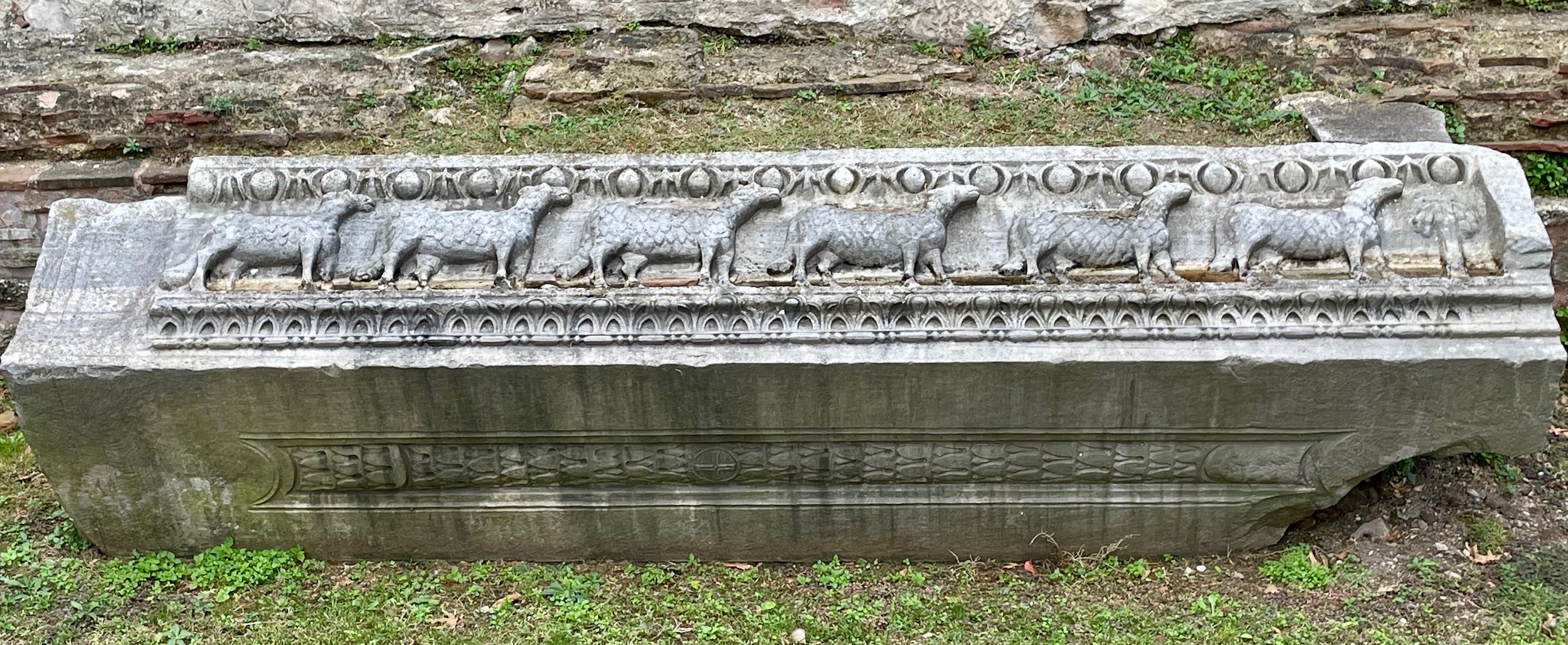
Justinian dealt with the rioters severely. I forgot to mention as we were visiting the grounds of the Hippodrome that this is where the riots began and that about 30,000 of them were penned in here when the army arrived and slaughtered every single one of them. He also vowed to rebuild a church that no amount of rioting, pillaging or looting would destroy. And he did.
Justinian hired two Greek architects, Anthemius of Tralles and Isidore of Miletus to design and oversee the construction. They were both well known polymaths famous for their mathematical and scientific talents. Incredibly Hagia Sophia was built in less than six years and was consecrated in 537. Considering that some Gothic cathedrals built almost a thousand years later often took hundreds of years to complete e.g. Canterbury took 343 years, this seems nothing short of miraculous. From 537 to 1528 it was the largest church in the world until surpassed by the Gothic cathedral in Seville, Spain.
I must confess that I was well along in years before I realized that Hagia Sophia is not named for Saint Sophia, an early Roman martyr, but rather means ‘Holy Wisdom’. Here’s a look at the ablution fountain outside the main entrance that was built in the 18th century. It is customary in Islam to do a ritual washing of the head, arms and feet before entering a mosque to pray and it is not unusual to see the faithful doing just that outside many mosques in Turkey. However, given that Hagia Sophia is always swarming with tourists, it is not the best place to perform one’s prayers and the ablution fountain here is now largely ceremonial, or at least it was until recently.
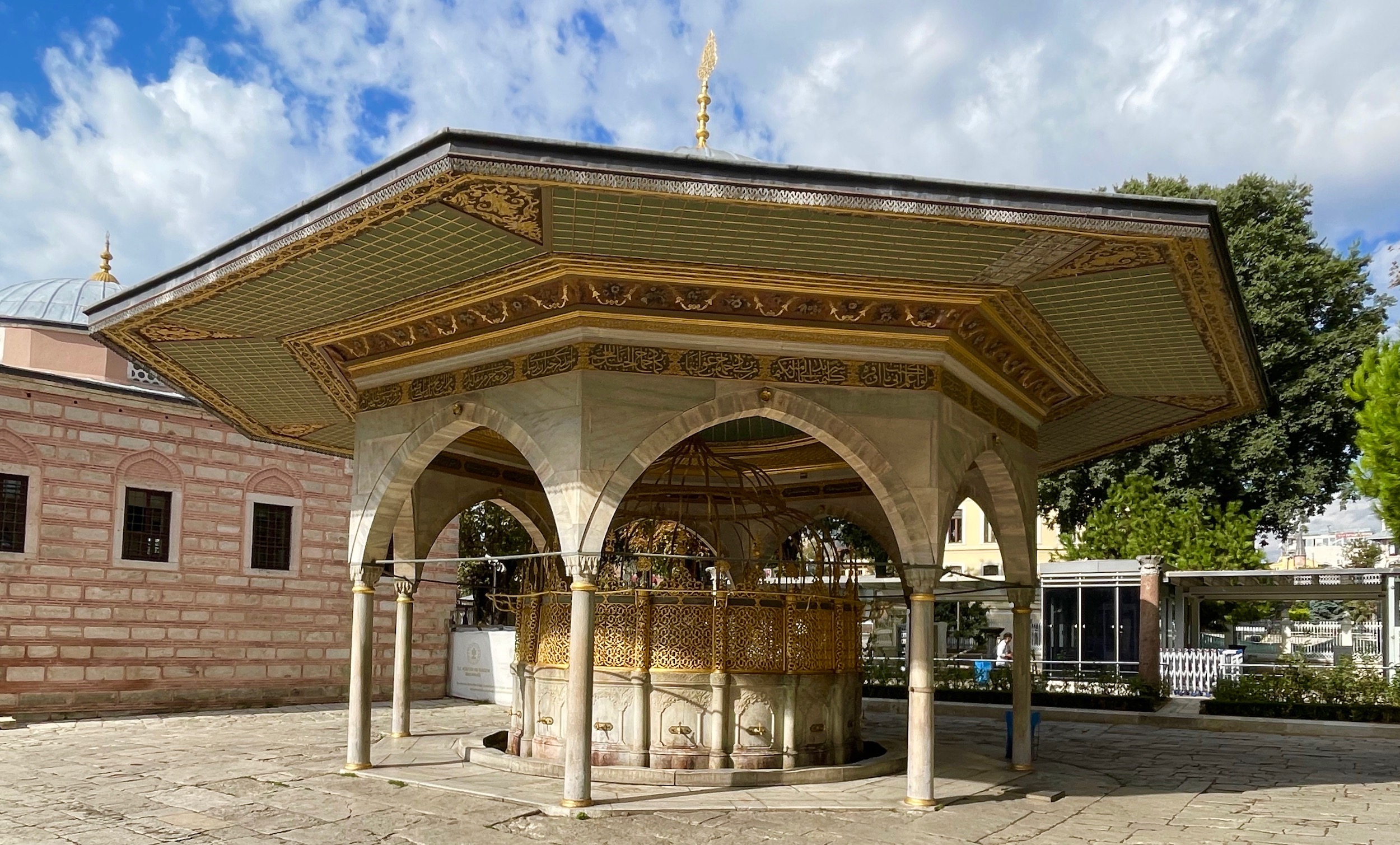
The last time I was here at Hagia Sophia it was a museum and you had to pay an admission fee, but now that it’s a mosque, if in name only, there is no fee. You do have to follow the same rules we first encountered at the Blue Mosque and remove your footwear. During its first incarnation as a mosque, the mosaics and other Christian symbols were either destroyed or plastered over. When it became a museum in 1935 under the direction of Ataturk, the plaster was removed and the beautiful marble floor once again revealed. The decision by current President Erdogan to rehallow Hagia Sophia as a mosque has been extremely controversial and is a classic case of pandering to his religious base. Considering that Hagia Sophia is the #1 tourist attraction in Turkey and before Covid drew almost four million visitors a year, this decision could have very negative long term consequences for the Turkish tourist industry. As it is the numbers have recently dropped significantly, but how much is due to Covid and how much due to the reversion to mosque status is anyone’s guess. The bottom line is that today there are no great lineups for whatever reason so let’s go inside and see if it’s still as grand as I remember.
This is the Vestibule Mosaic which is over the south entrance. It depicts the Virgin and Child with Justinian on the left and Constantine on the right. Justinian is holding and offering the Hagia Sophia to the couple while Constantine is offering the city of Constantinople. It is an immensely powerful image that must have struck awe in the faithful as they entered the church.
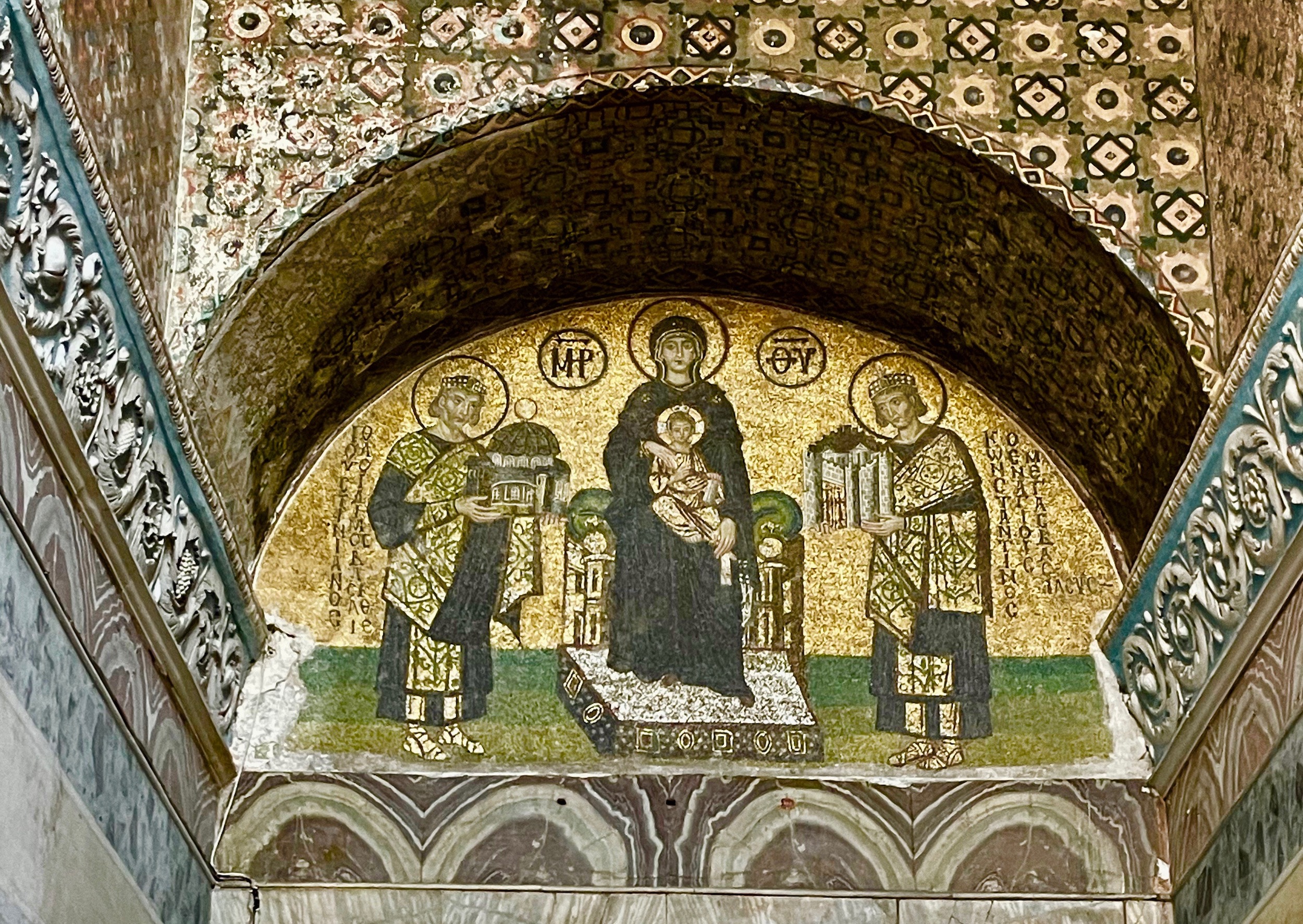
It is well nigh impossible to describe the sense of absolute wonder that overcomes one the first time you see the interior of Hagia Sophia. Even seeing it for the second or third time it still amazes me, as it does today. This is truly a sight for the ages and you’ll be thanking yourself for taking this trip from the moment you cross the threshold. I have never taken or even found on the internet a photo of the interior that comes remotely close to capturing the grandeur of Hagia Sophia’s interior. This is my best effort. As you can see there is still a lot of restoration work to be done.
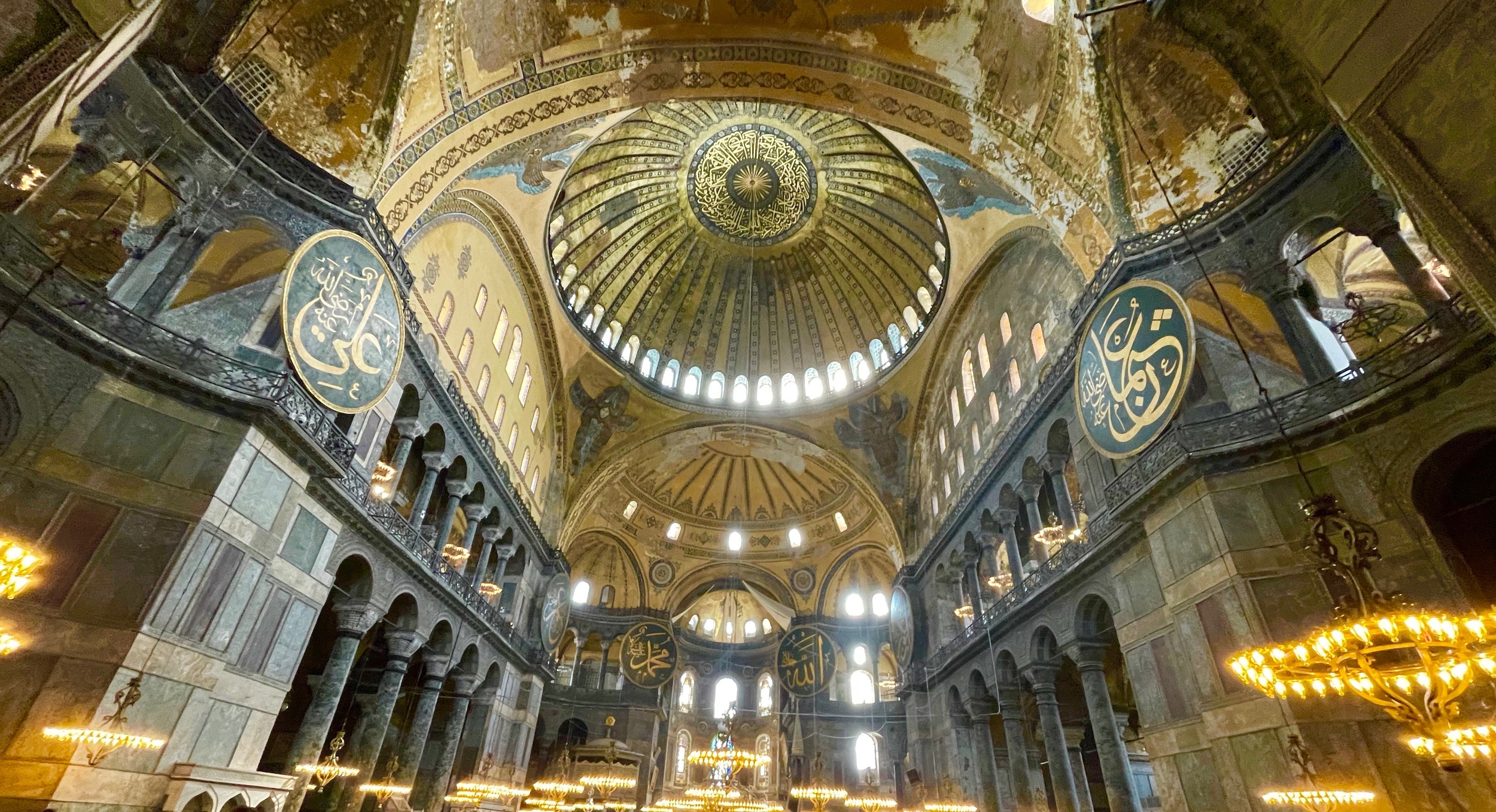
So instead I’m going to concentrate of some of the details. This of course is the dome, the second largest in antiquity after the Pantheon in Rome.
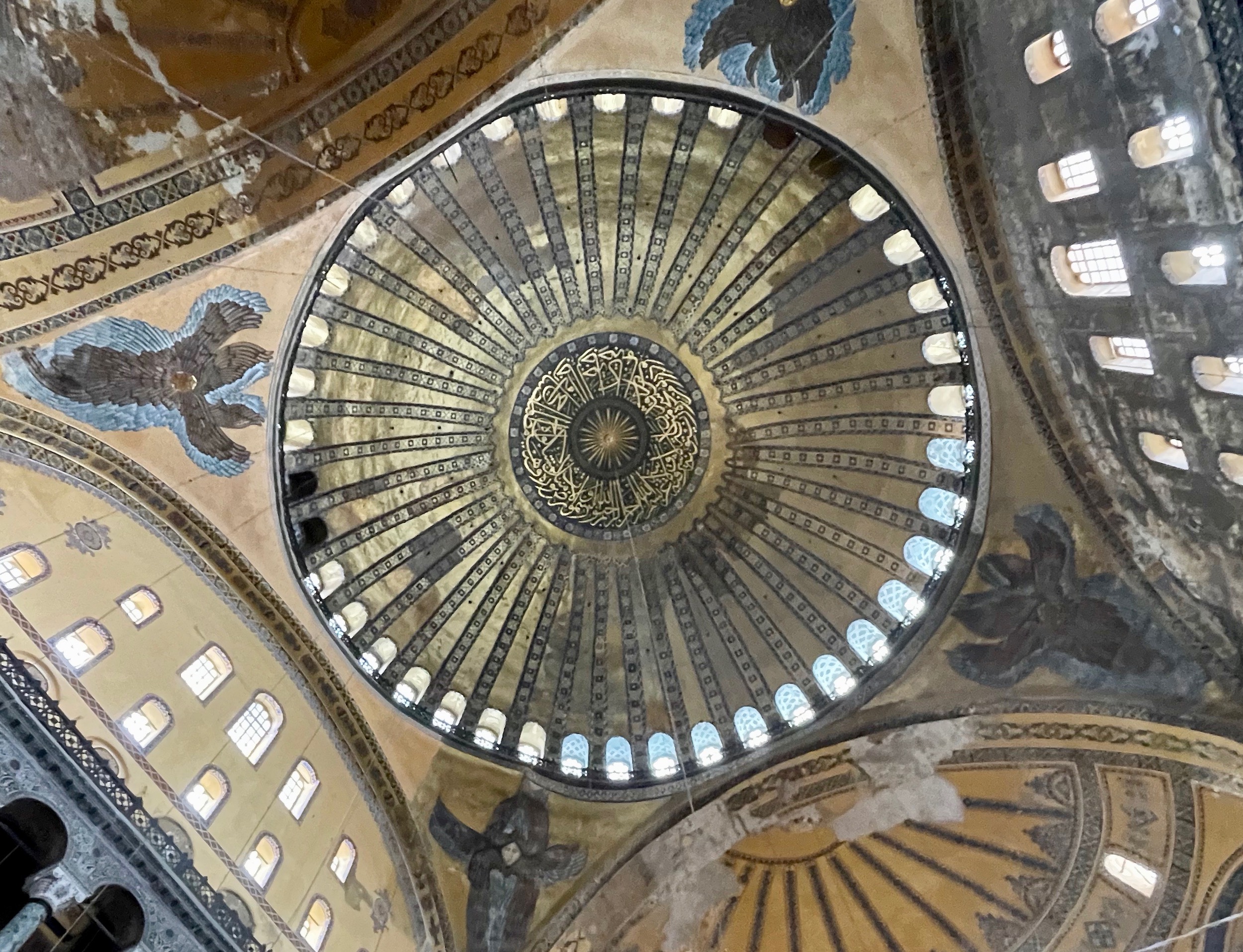
The four figures you see above are actually angels which are prominent in both Christian and Islamic doctrine.
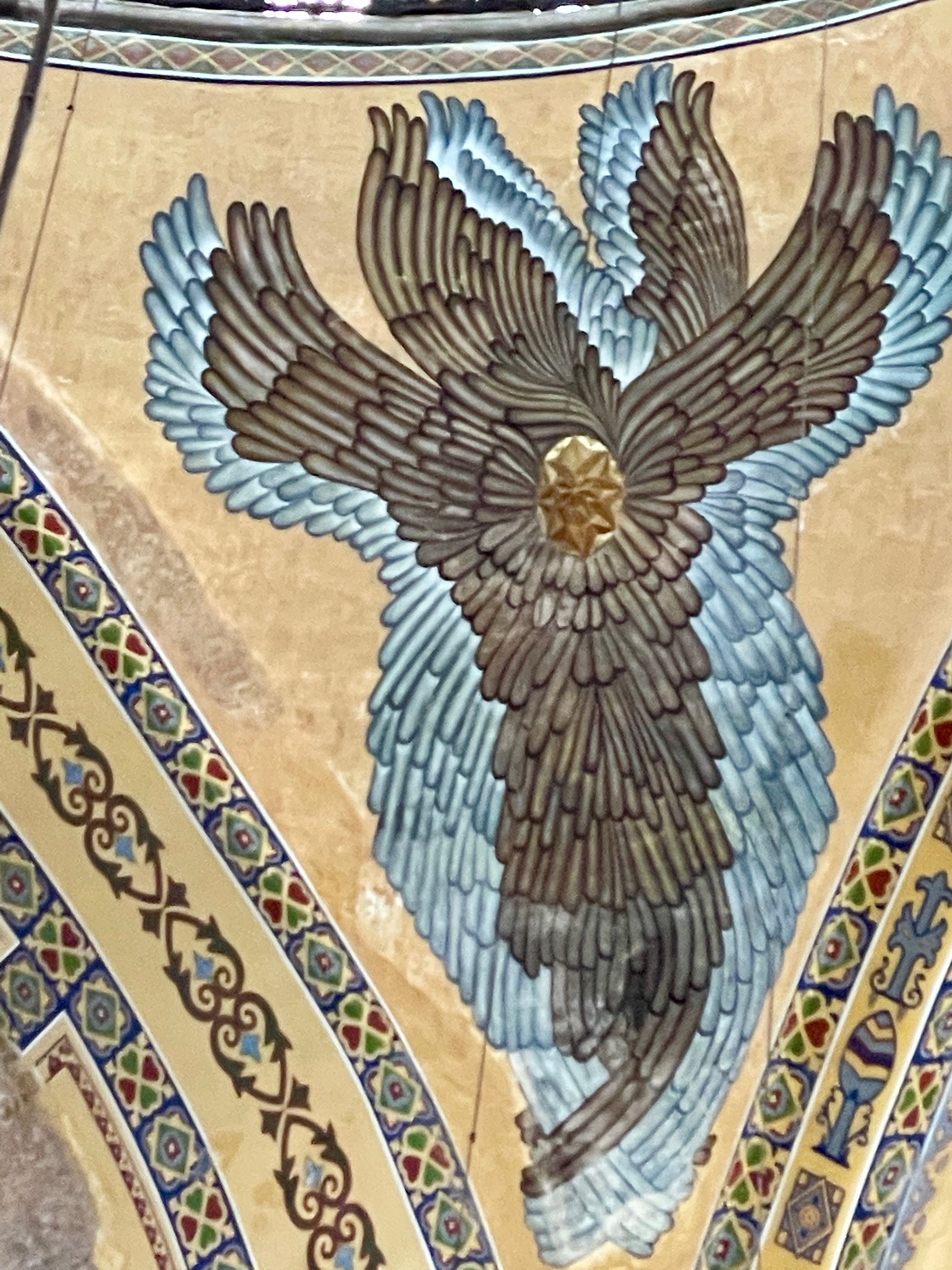
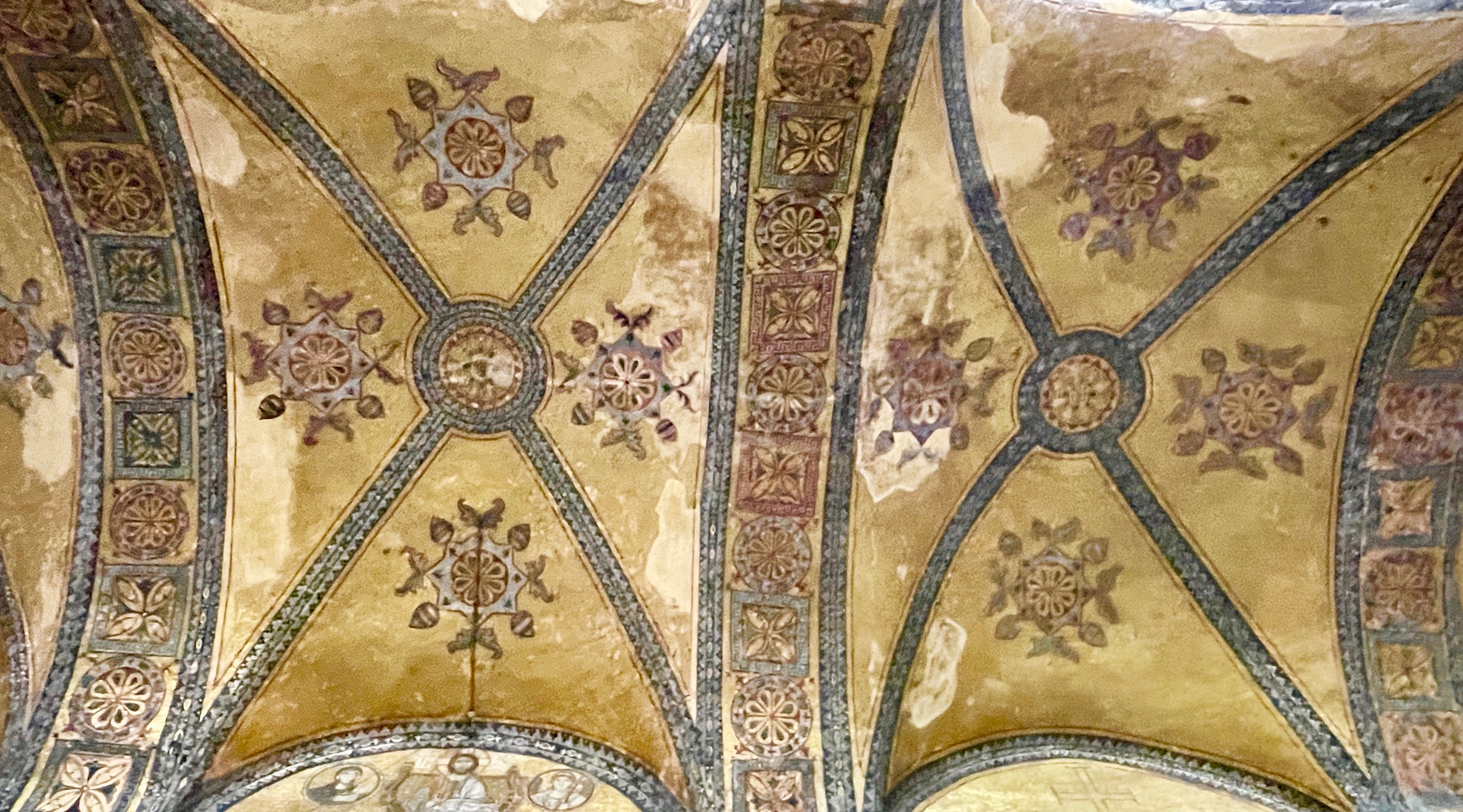
This is a closer look at portions of the ceiling which shows that there is still much restoration work to be done. How the transition to a mosque will affect that process remains to be seen.
This is the omphalion which literally means ‘navel of the earth’ and was once the spot upon which Byzantine Emperors were coronated.
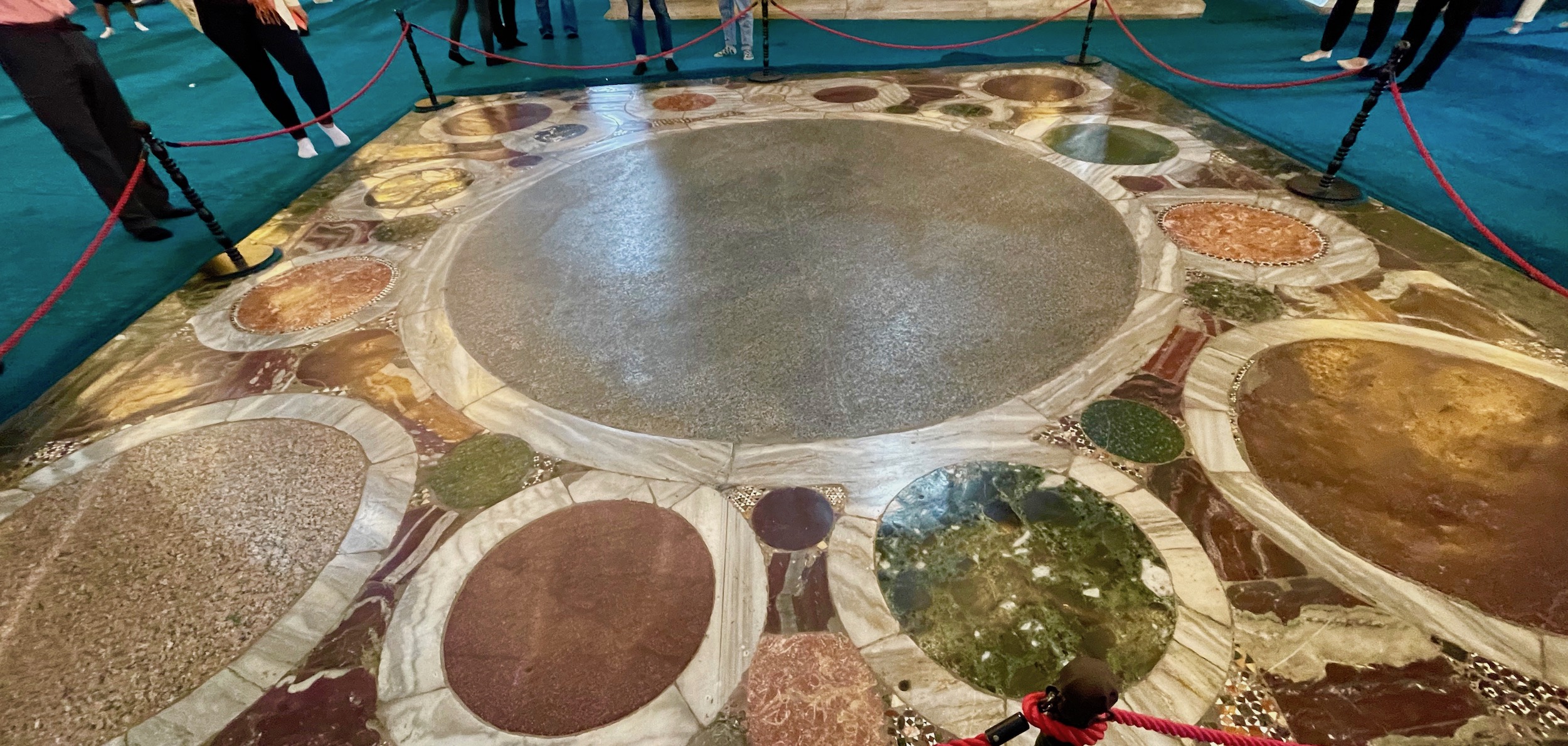
The one thing that separates Hagia Sophia from later Gothic cathedrals is the sense of open space which is created by the massive dome. However, there are 140 columns that Justinian had brought from all over the eastern Roman Empire including eight from the Temple of Artemis in Ephesus, one of the Seven Wonders of the Ancient World. We will look upon that site later in this tour where there is now only one column remaining.
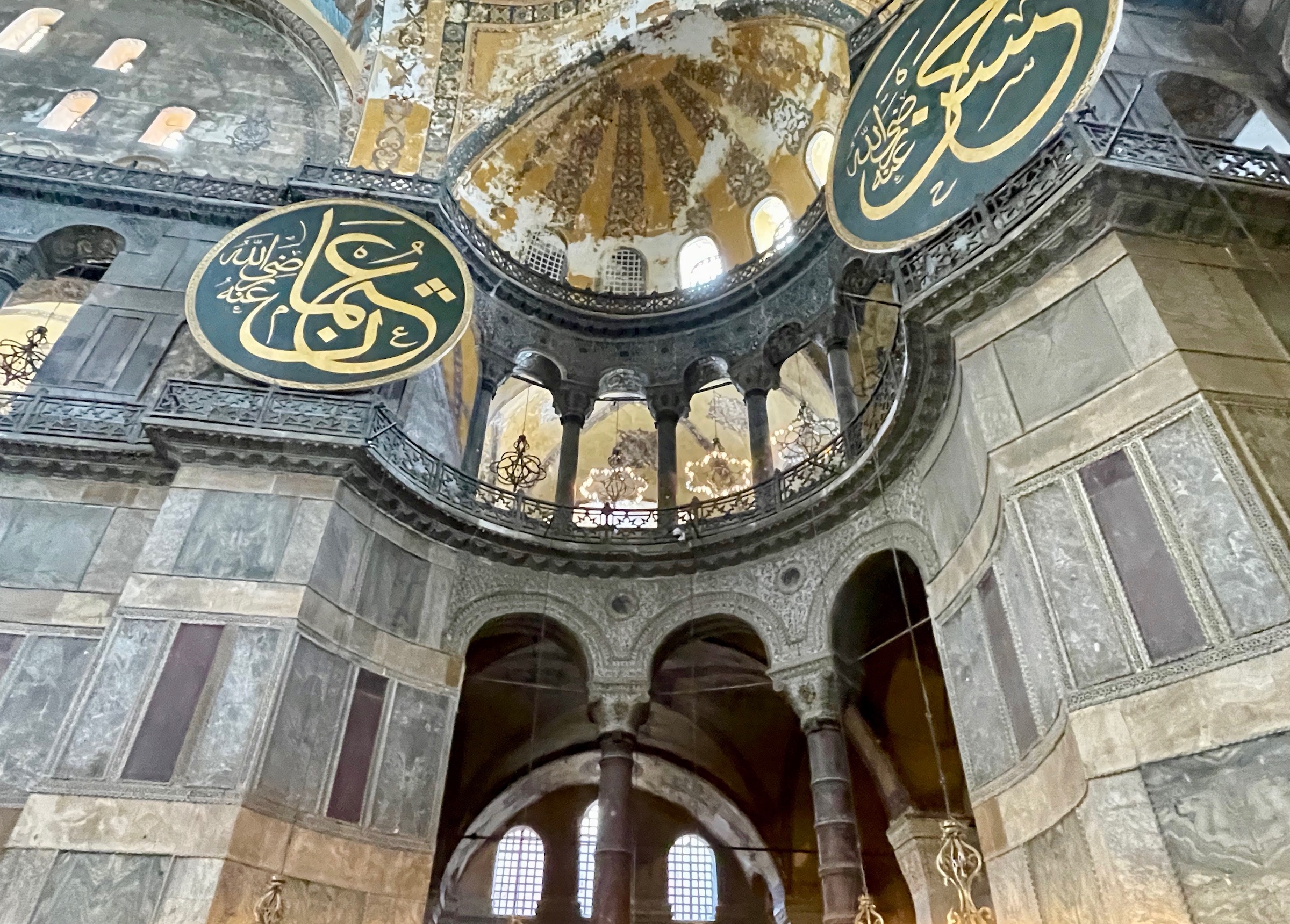
The conversion to a mosque has meant the addition of several items found in every mosque including this minbar from where the imam leads the prayers and preaches sermons.
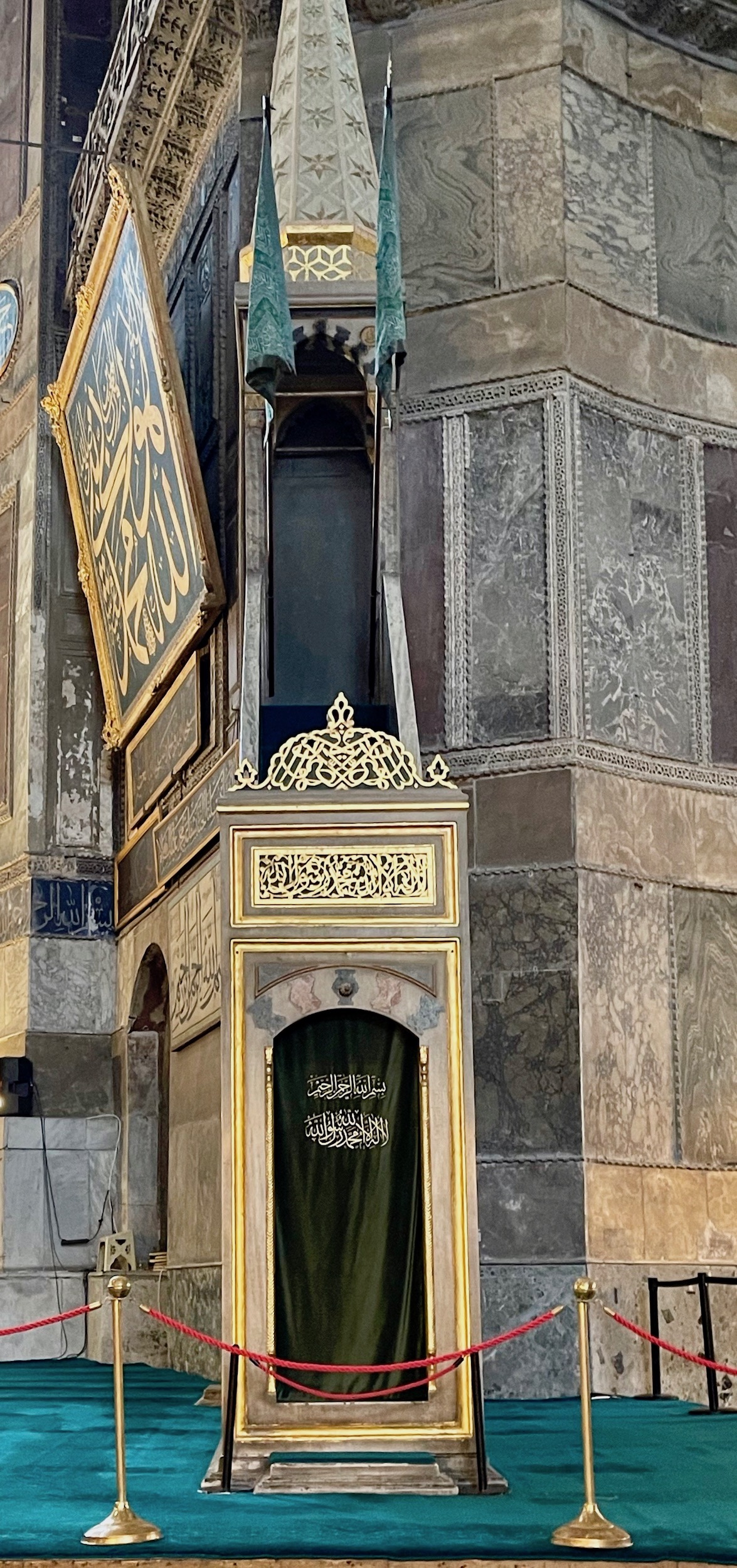
While the conversion to a mosque has changed some things, it has not spoiled the overall effect this place would have on anyone who passes through it doors. Nevertheless, even as a person of no religion, I found myself taking umbrage at these changes. I can understand why Mehmet the Conqueror would have made the original conversion during a period of time when Christians and Muslims were at perpetual war. And I fully understand why Ataturk turned it into a museum. However, this latest change brought about solely to placate religious radicals has damaged Turkey’s reputation and no doubt put off a lot of people from visiting this otherwise wonderful country.
If you would like a private tour of Hagia Sophia you might try the folks at https://hagiasophiatickets.com.
We have one more place to visit on our walk around the Sultanhamet and as we head there we pass the only surviving remnants of the Hippodrome, these crumbled brick walls.
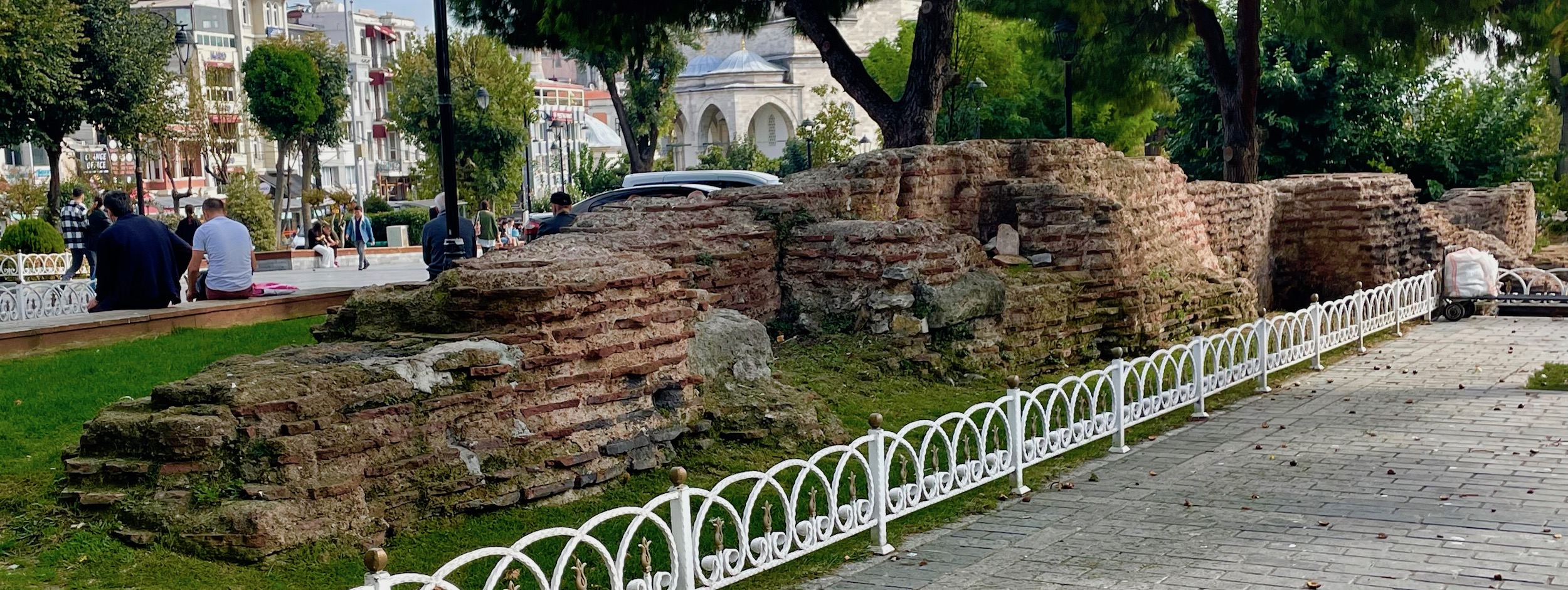
The Cistern of Philoxenos
Most visits to the Sultanhamet include a stop at the Basilica Cistern which is the largest of many cisterns found throughout Istanbul. It is quite a site with 336 columns all of which have their base in the water. However, as its website states -‘ The Basilica Cisterm will be closed for a while…’ So Yasemin is taking us to the Cistern of Philoxenos which is not far from the site of the Hippodrome and is the second largest cistern in Istanbul. Often referred to as the Cistern of 1001 Columns, which of course would make it much larger than the Basilica Cistern, it actually has only 224 columns. Apparently the Turkish name for the place – Binbirdirek has something to do with the discrepancy.
These cisterns date back to the time of the Romans and this one was apparently restored by Justinian in the 6th century. Their purpose was to store water, but today they are tourist attractions in their own right. The difference between this cistern and the Basilica Cistern is that this one has no water and you walk on the marble floor. In the Basilica Cistern you walk on wooden walkways that are fixed above the water line.
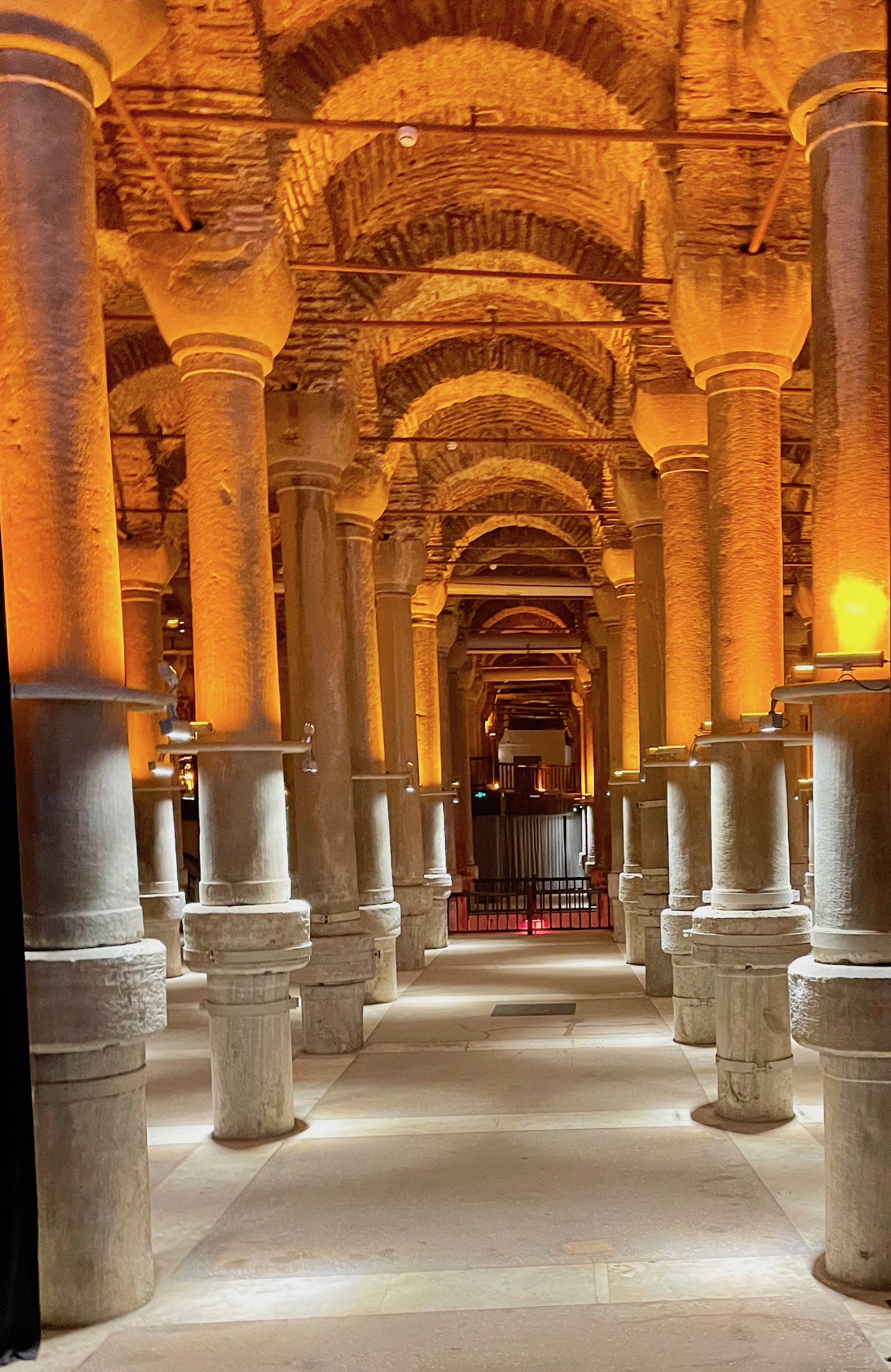
What makes the cisterns so interesting are the hypostyle chambers that really just means a shitload of columns holding up a roof. The most famous hypostyle in the world is that of the Temple of Karnak in Egypt which I visited on a trip with Adventures Abroad a few years ago.
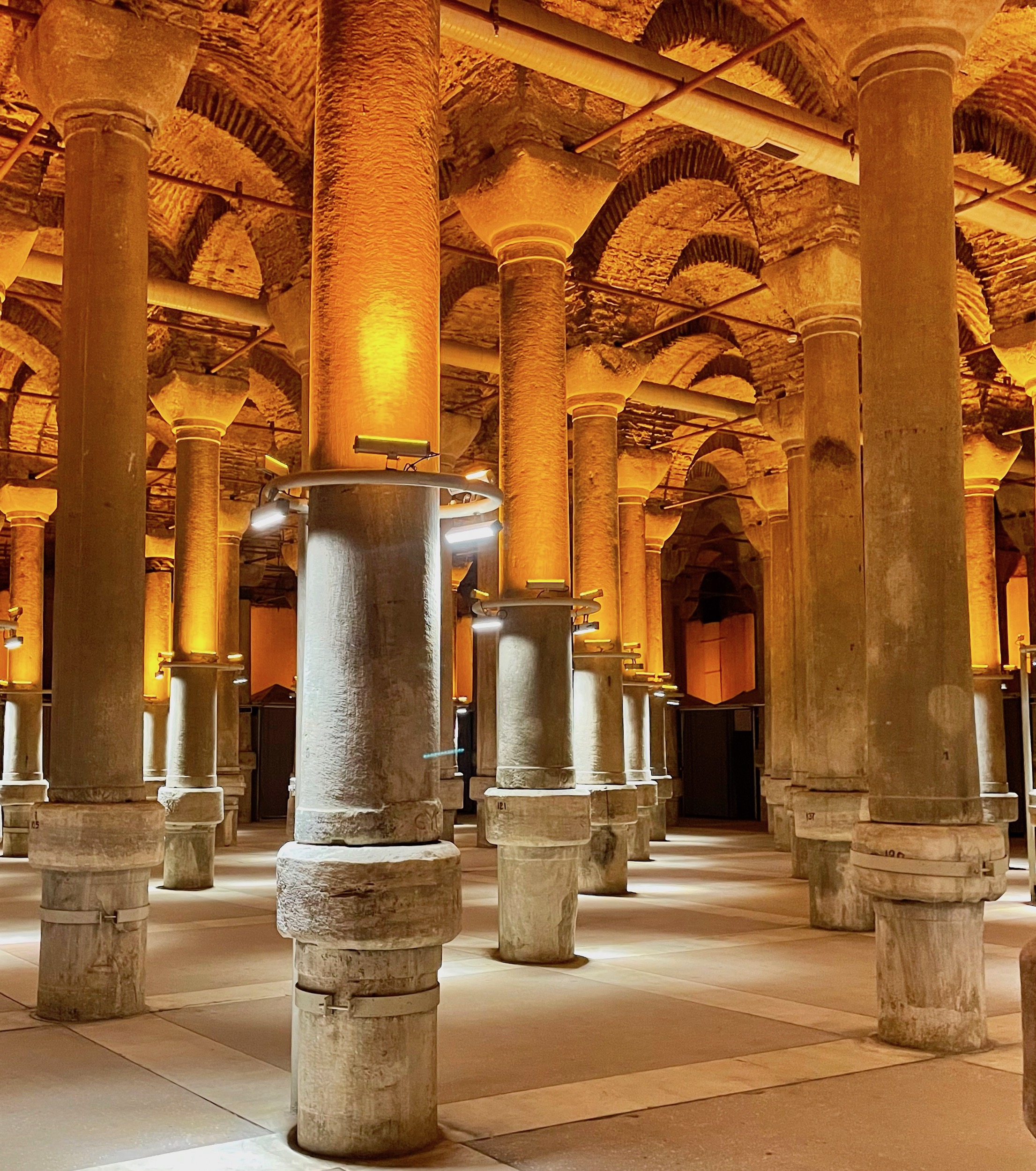
This cistern has a second story from where you really appreciate the symmetry of a hypostyle. As you can see, it’s not exactly crowded.
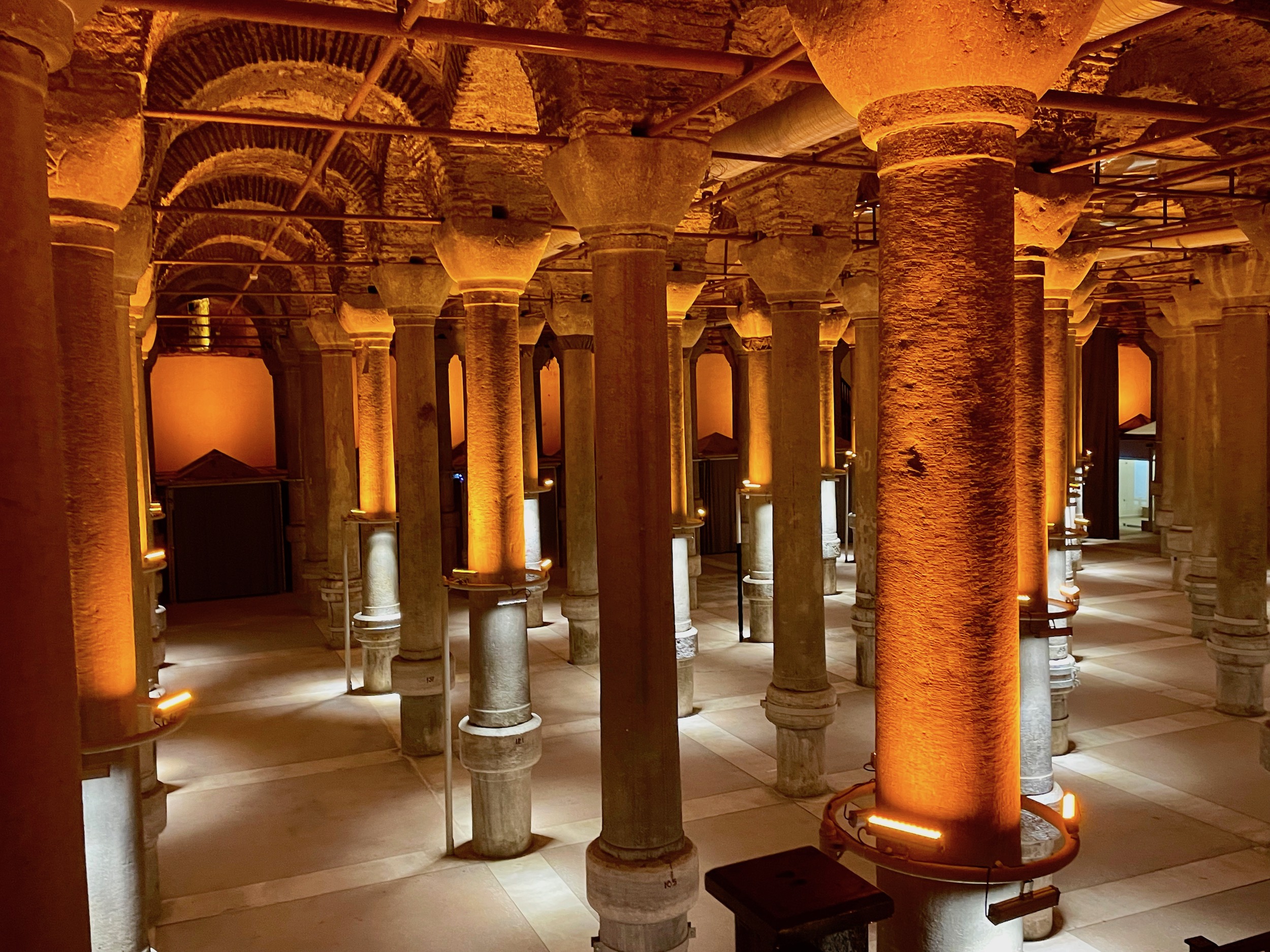
And while I’m here, say hello to Alison.
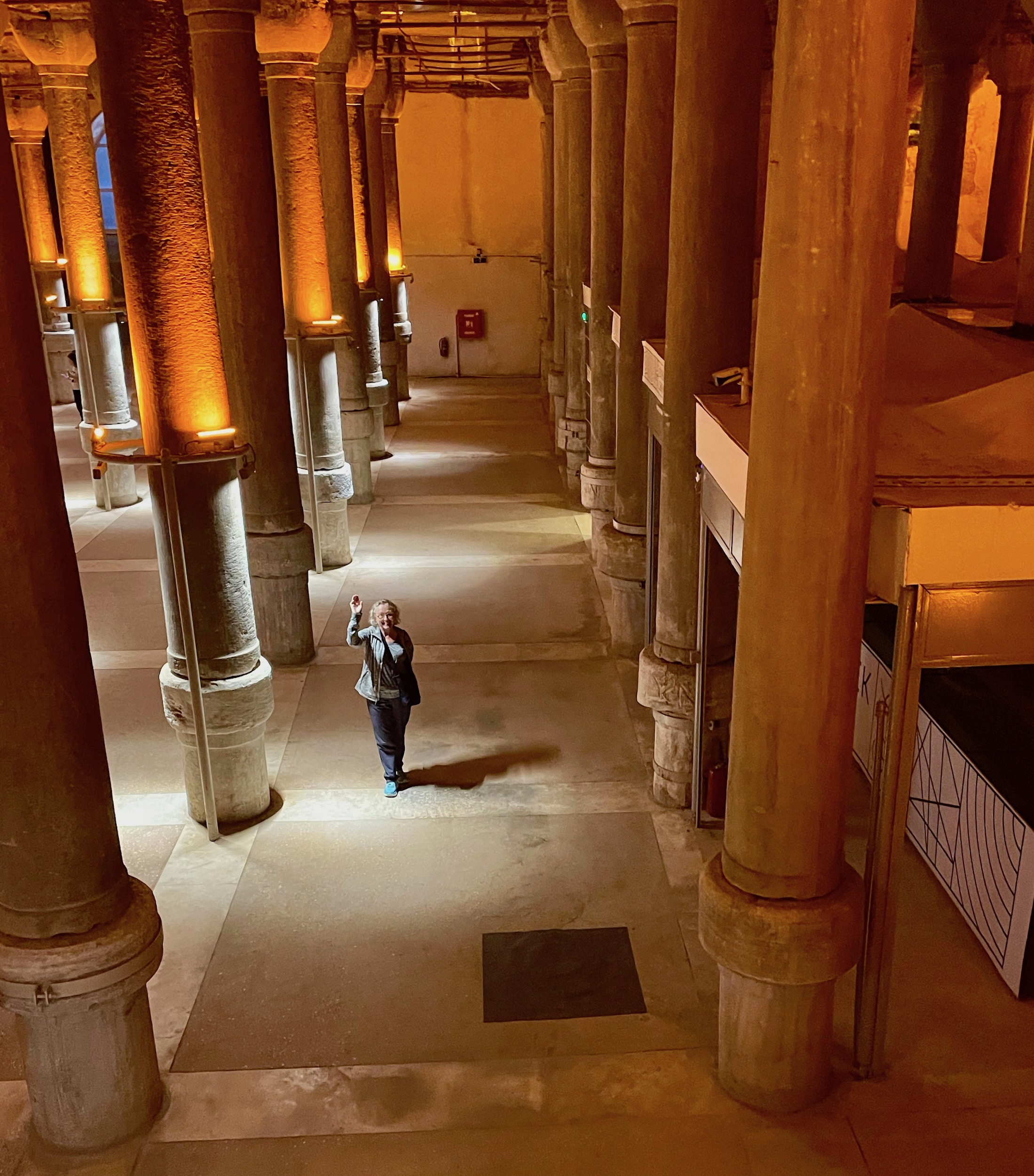
Well that concludes our tour of the Sultanhamet and our visit to Hagia Sophia. The tour still had enough free time before dinner to visit the Grand Bazaar which Alison and I took a pass on choosing to visit the Museum of Turkish and Islamic Art which is also in the Sultanhamet, instead. Rather than being harassed by hundreds of hawkers we enjoyed the peace and tranquility of this former palace turned museum.
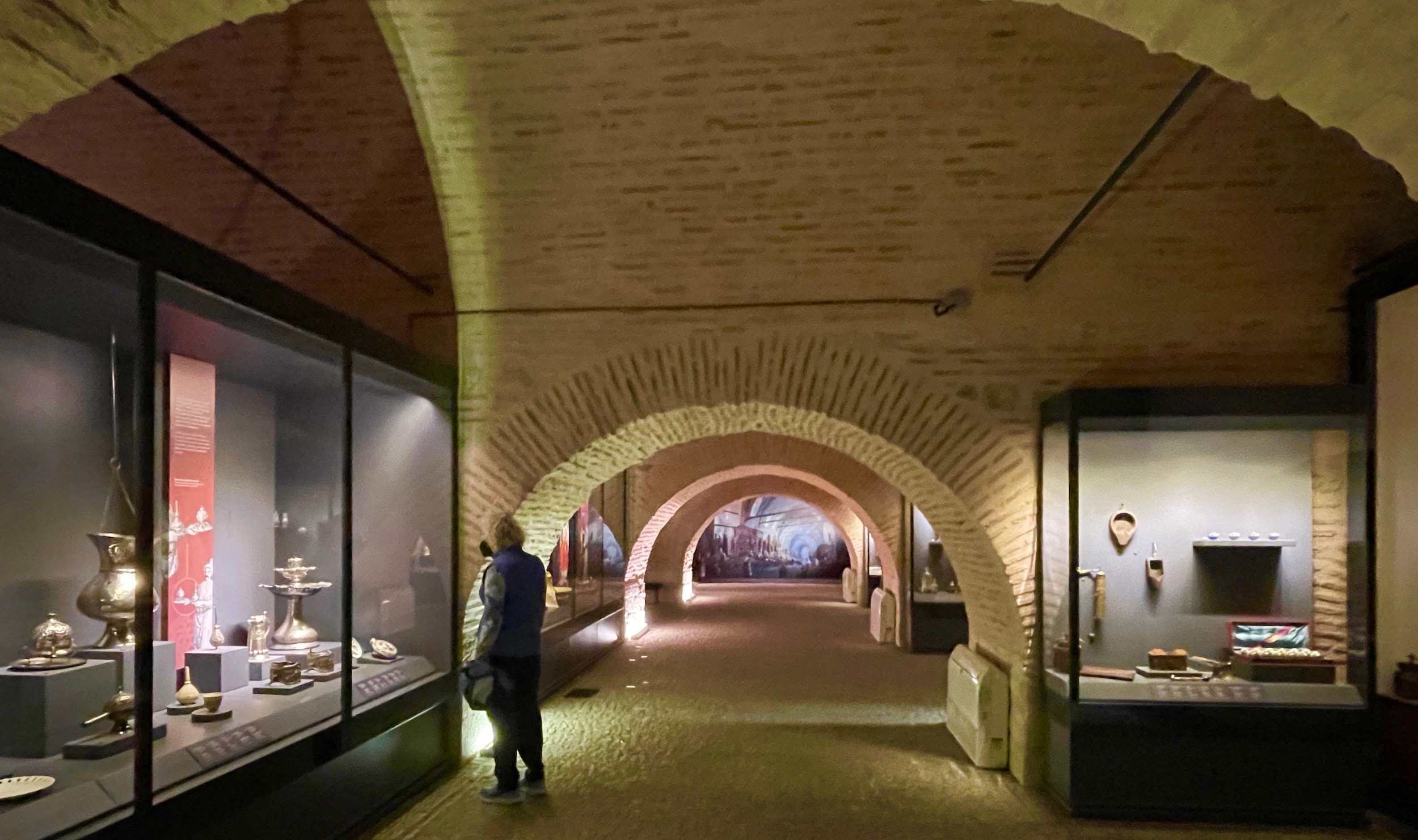
Las Tapas Restaurant
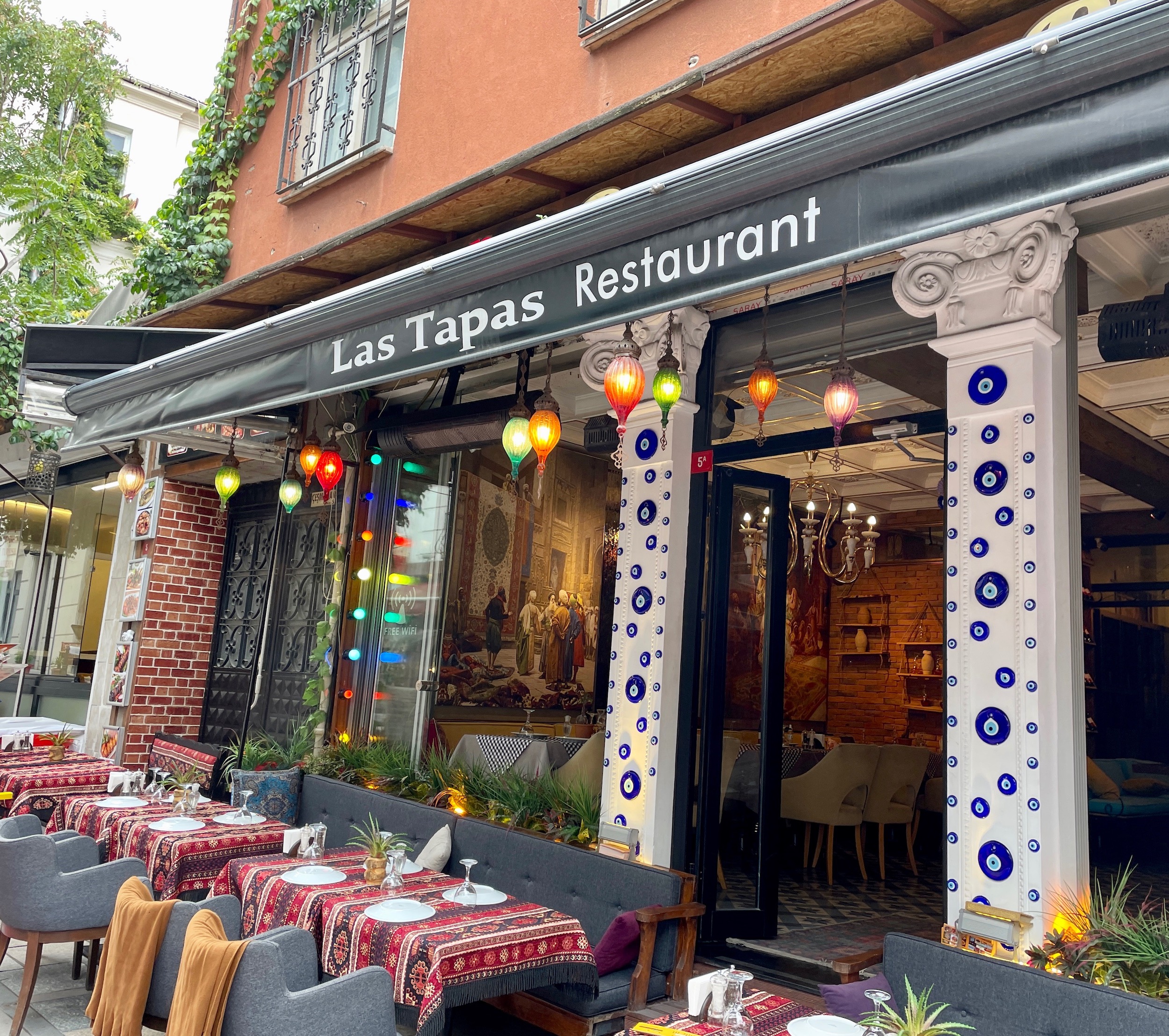
That evening Yasemin took us to a very interesting restaurant in the Sultahamet. Despite the name, Las Tapas is not a Spanish, but serves a fully Turkish menu including some dishes I had not tried before. Comlek Kebabi is a meat and vegetable stew that is slow cooked in a sealed pottery vase. Just before serving the dish is lit on fire.
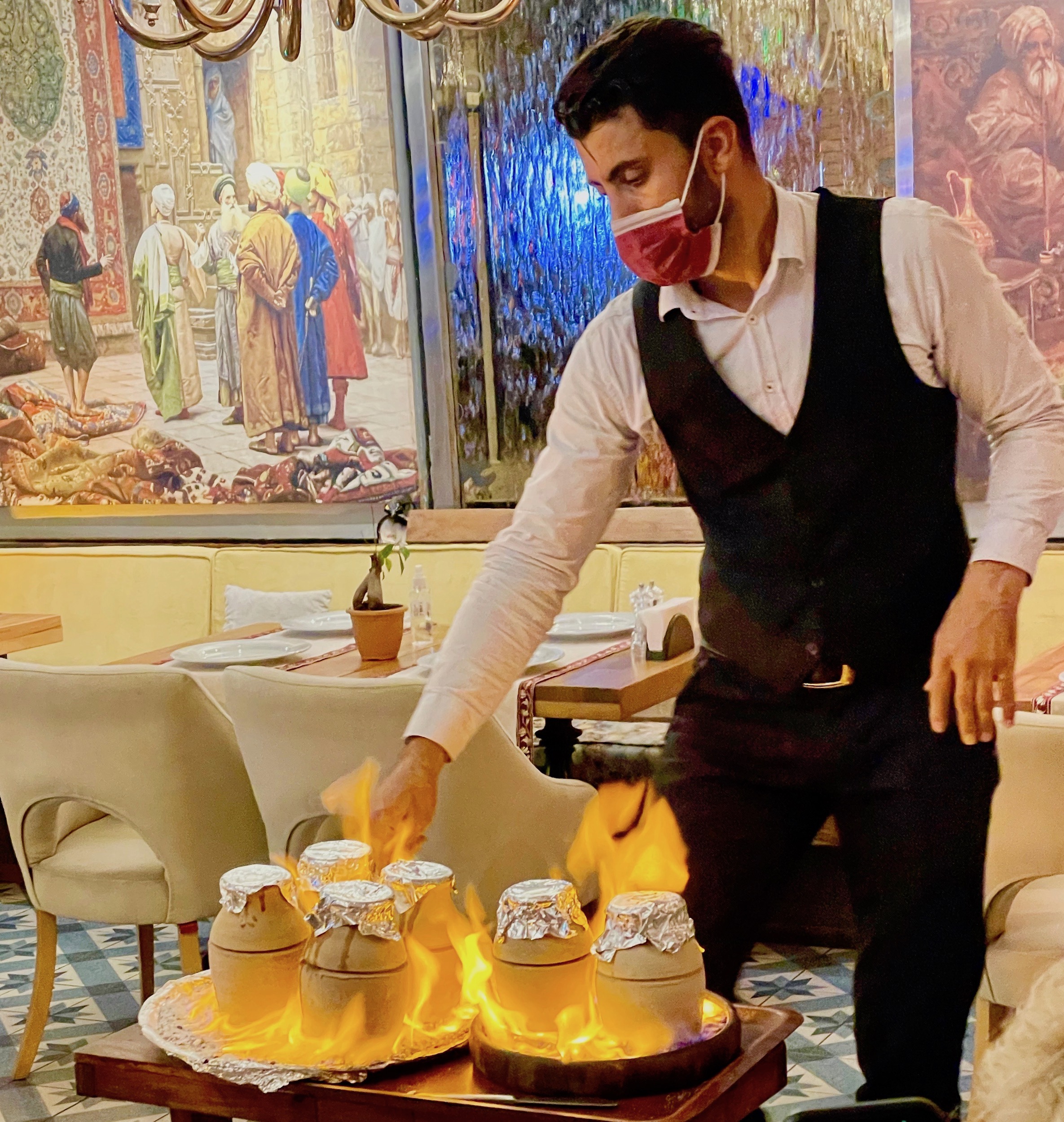
It is then carried to the table and with a great flourish the tops are broken (literally).
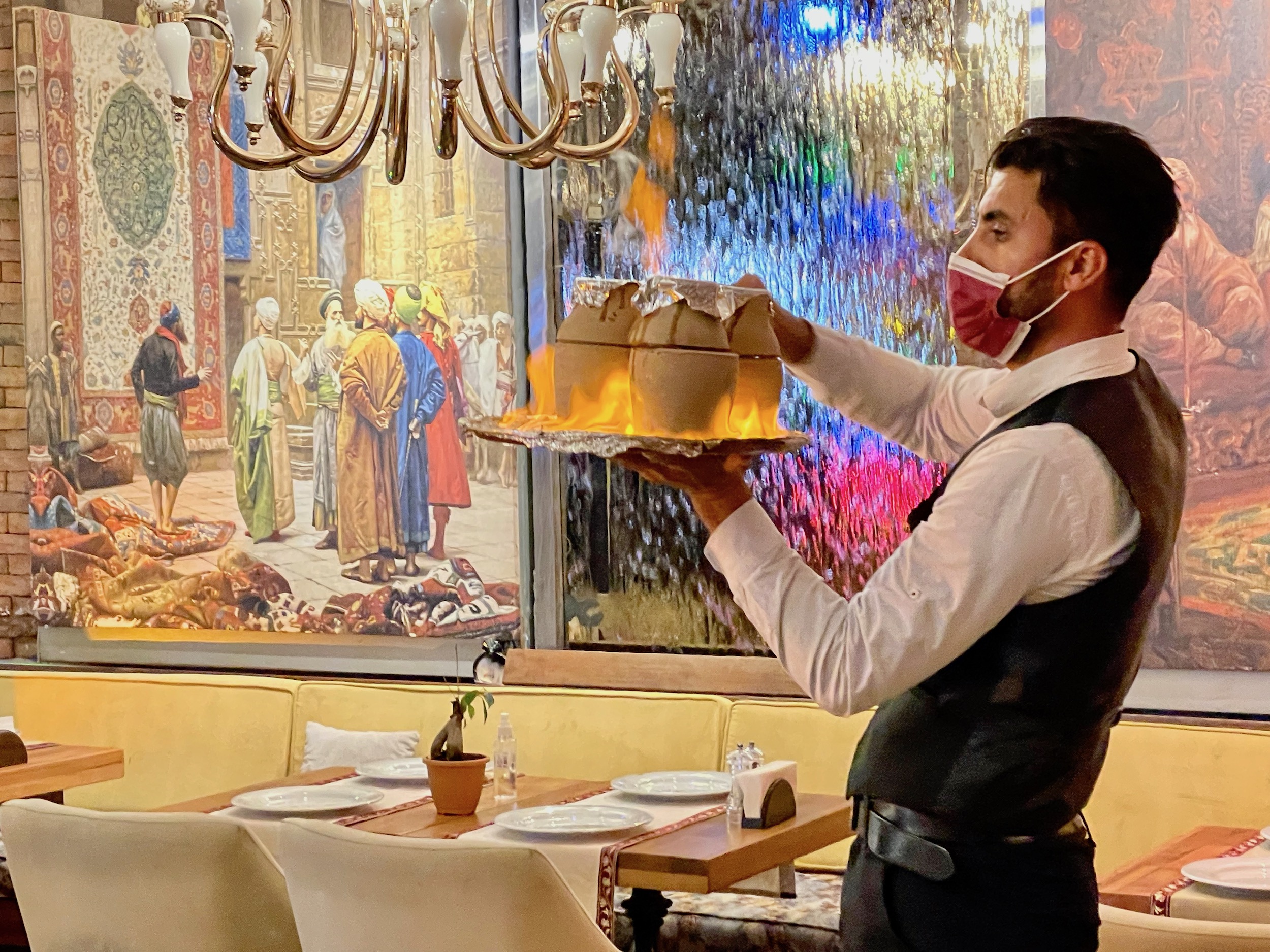
And voilà or whatever the equivalent is in Turkish, you have this wonderful tasting steaming dish in front of you. Sure it’s hokey, but if the food lives up to the hokiness then I’m all for it and the comlek kebabi at Las Tapas definitely does.
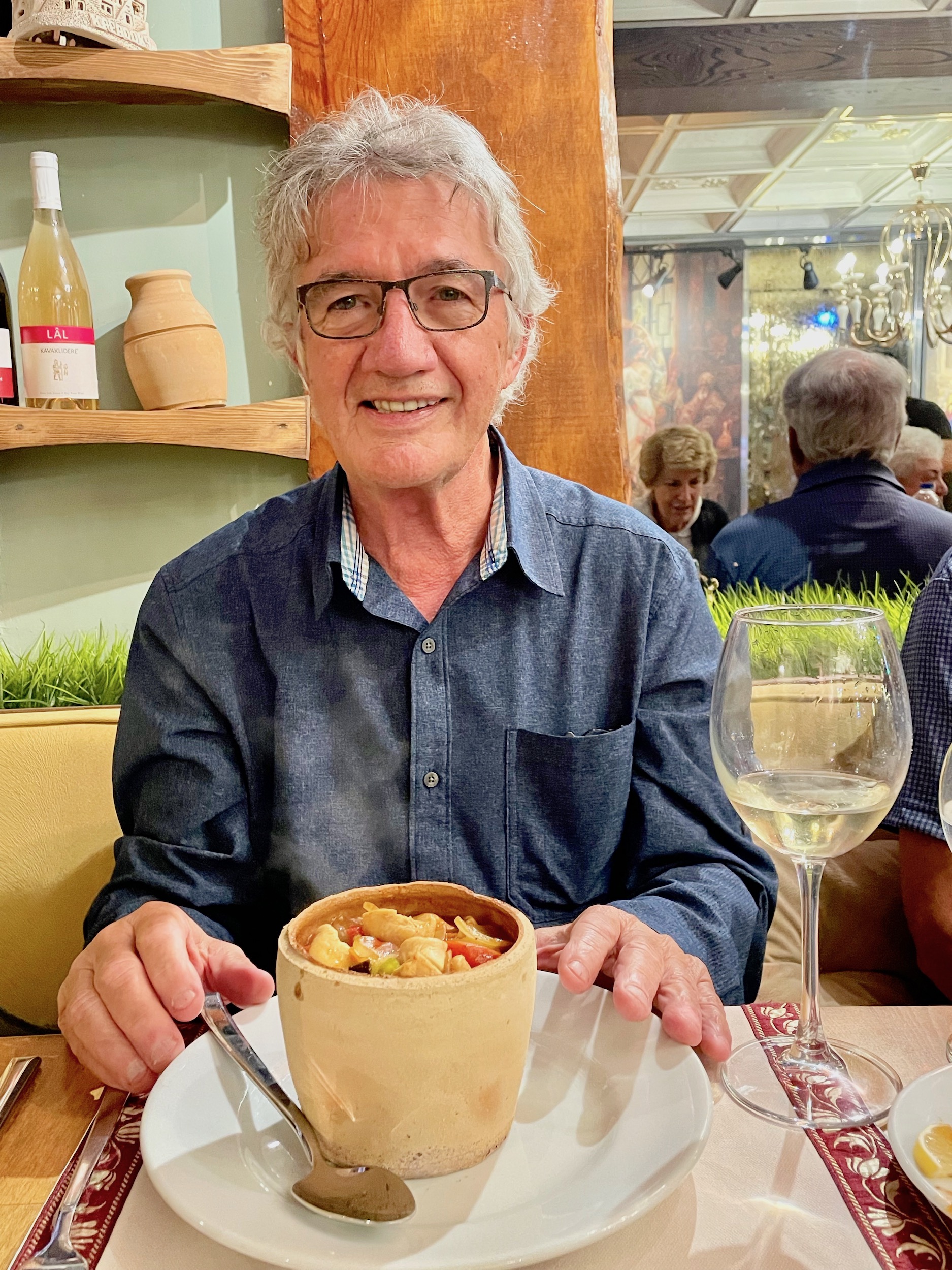
Alison had another Turkish dish considered to be an example of the best of Turkish cuisine and it better be with a name like Sultan’s Delight. It’s a lamb stew traditionally, but this version used chicken. What makes it special is the begendi which is a smokey eggplant (aubergine in Europe) cheese sauce that Alison said was unbelievably good and apparently fit for a sultana.
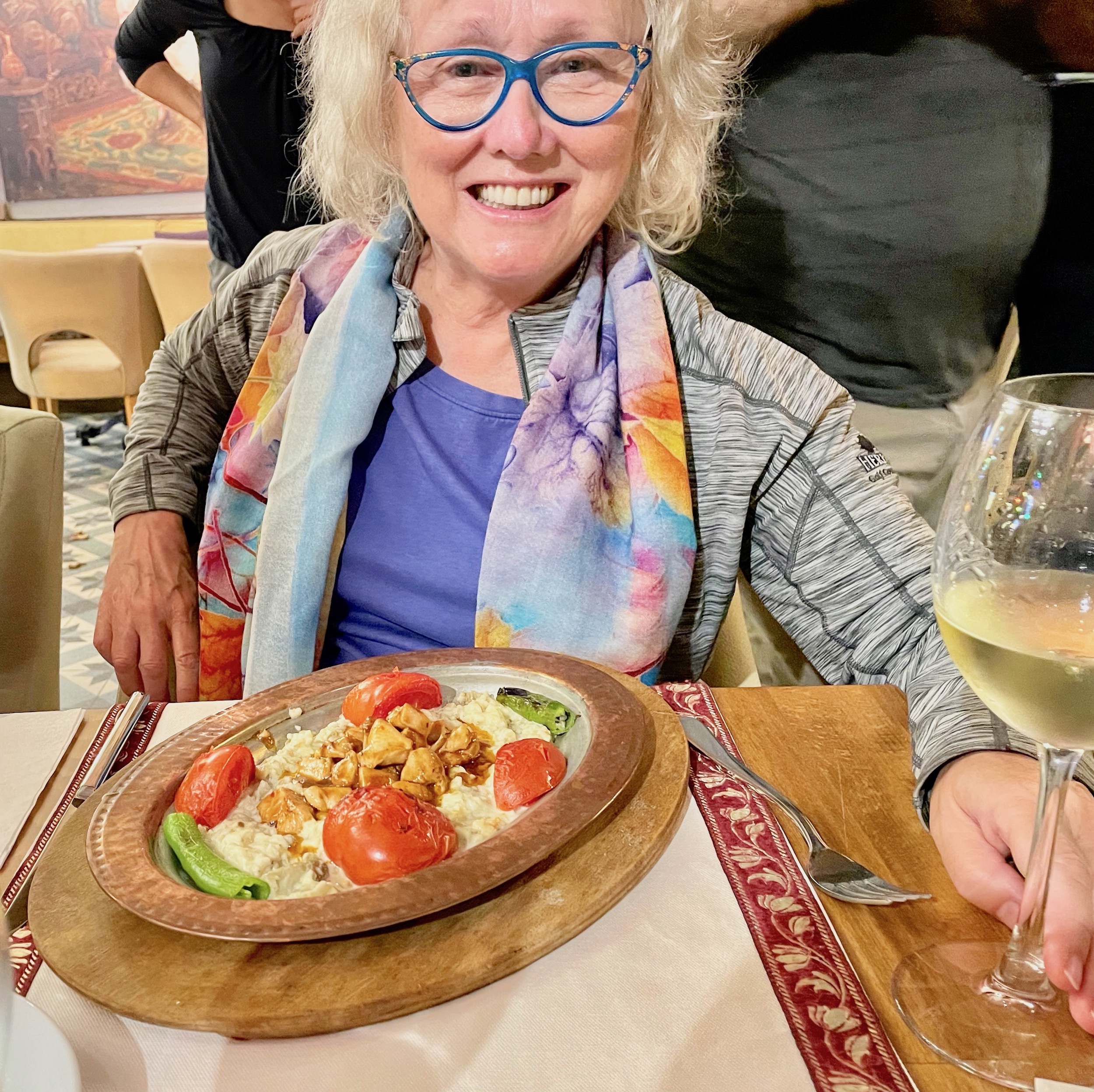
We enjoyed Las Tapas so much that we returned for lunch at the end of the tour and had a nice chat with the young owner whose English was pretty good. He told of us of his aspiration to make Las Tapas one of the best restaurants in the Sultanhamet and we told hime he was already there. We certainly plan to return when we come back to Istanbul for the start of the Via Egnatia tour with Victor Romagnoli in 2023.
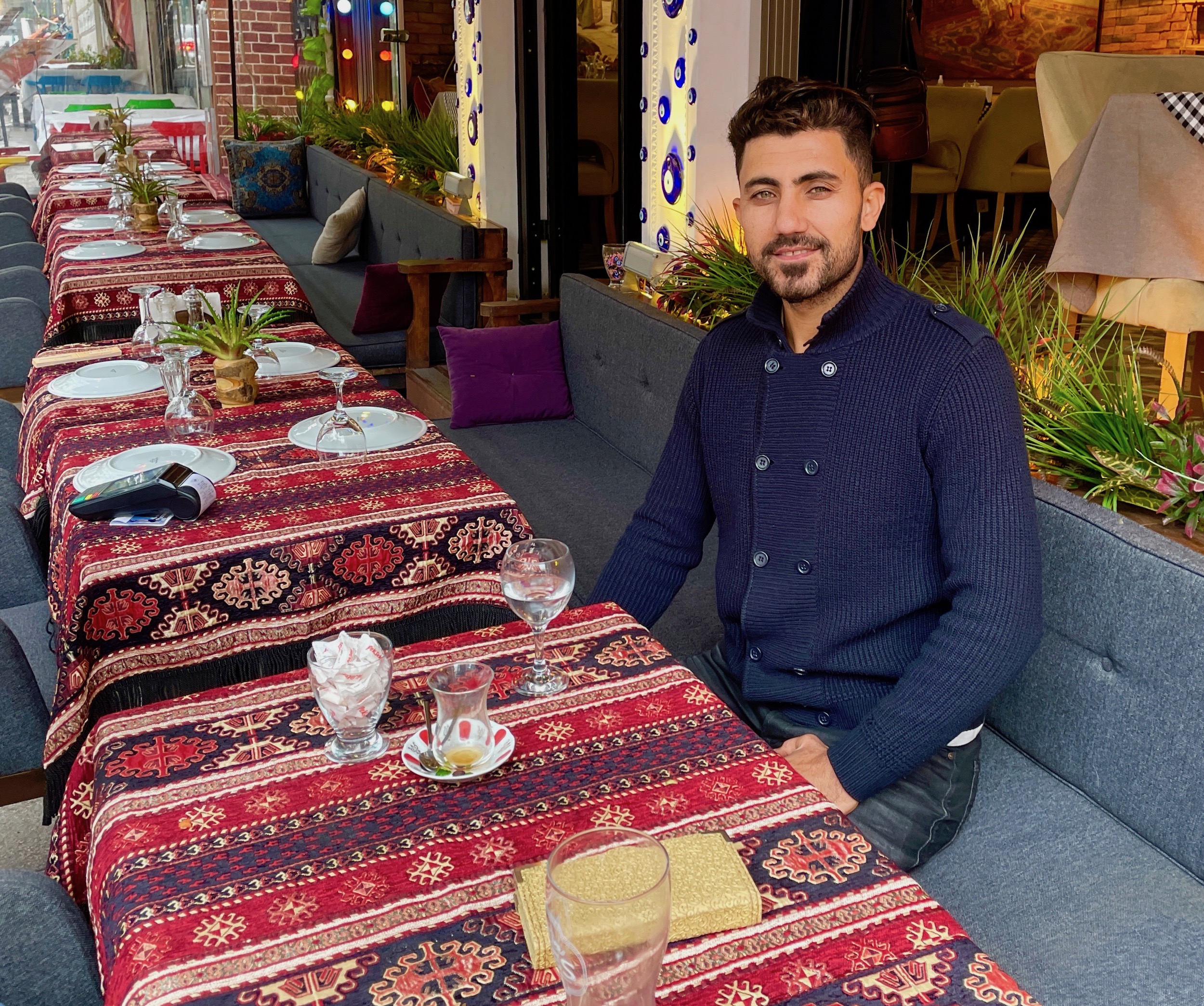
Tomorrow we’ll leave this fabled city and begin our tour of western Turkey with a visit to the battlefields of Gallipolli. I hope you’ll join us.
UDATE:
We did return to Las Tapas last night before the start of the Via Egnatia tour in April 2023 and found that it has indeed become very popular. In fact it is now #3 on Trip Advisor out of 9,866 restaurants in Istanbul. After running the gauntlet between the barkers at all the near empty restaurants in the Sultanhamet in the early evening it was great to come across Las Tapas loaded with mostly North American tourists. It was too early for Turks to be out dining.
Once again Alison had the Sultan’s Favourite – Chicken with Aubergines (eggplant) in an amazing sauce and it was as good as remembered.
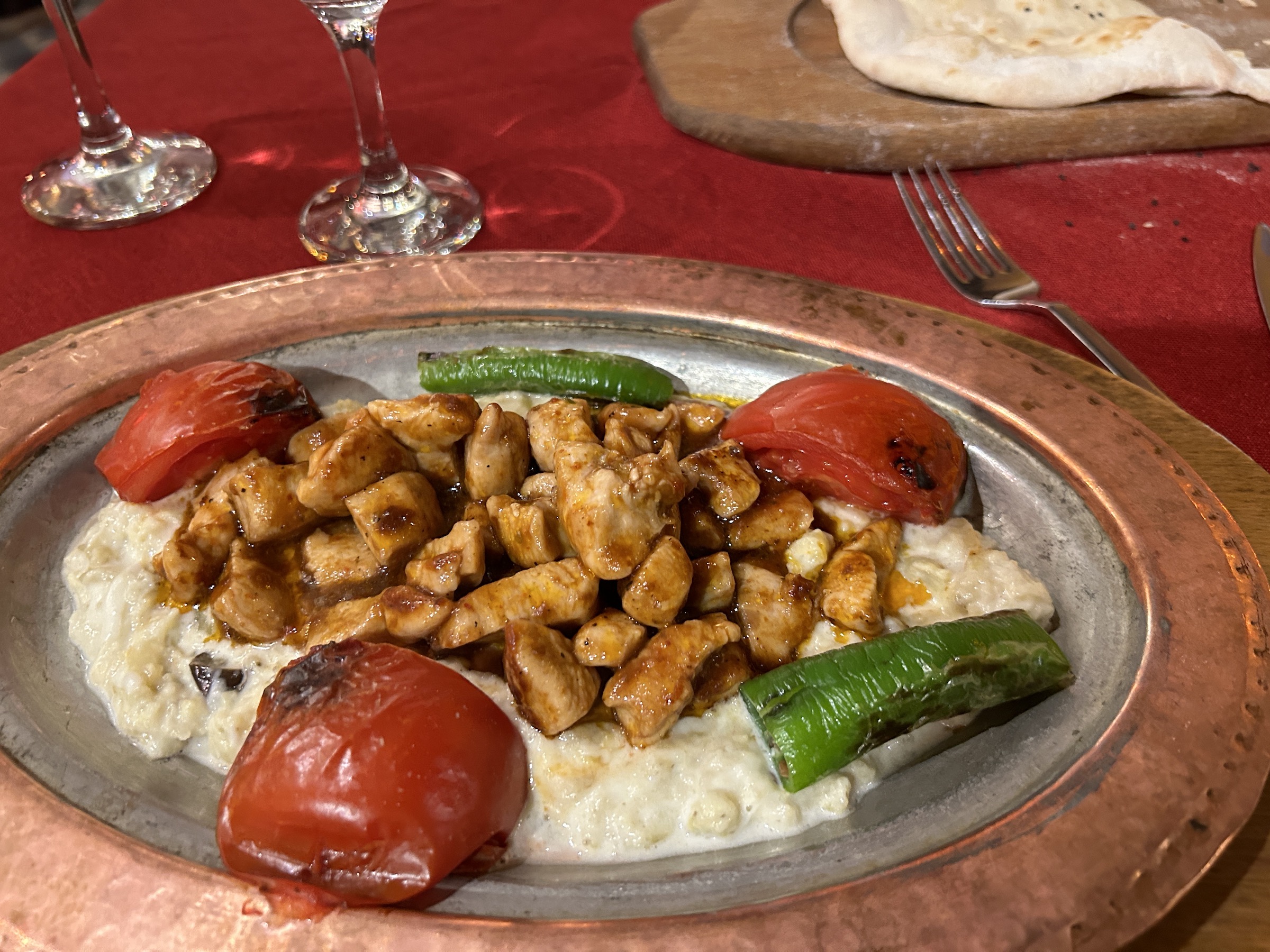
I had the spicy meat kebab which had simply awesome flavour. Not overly spiced, but instead subtly spiced if that makes sense. Kebabs are the backbone of Turkish meat cuisine and after you try this dish you’ll know why.
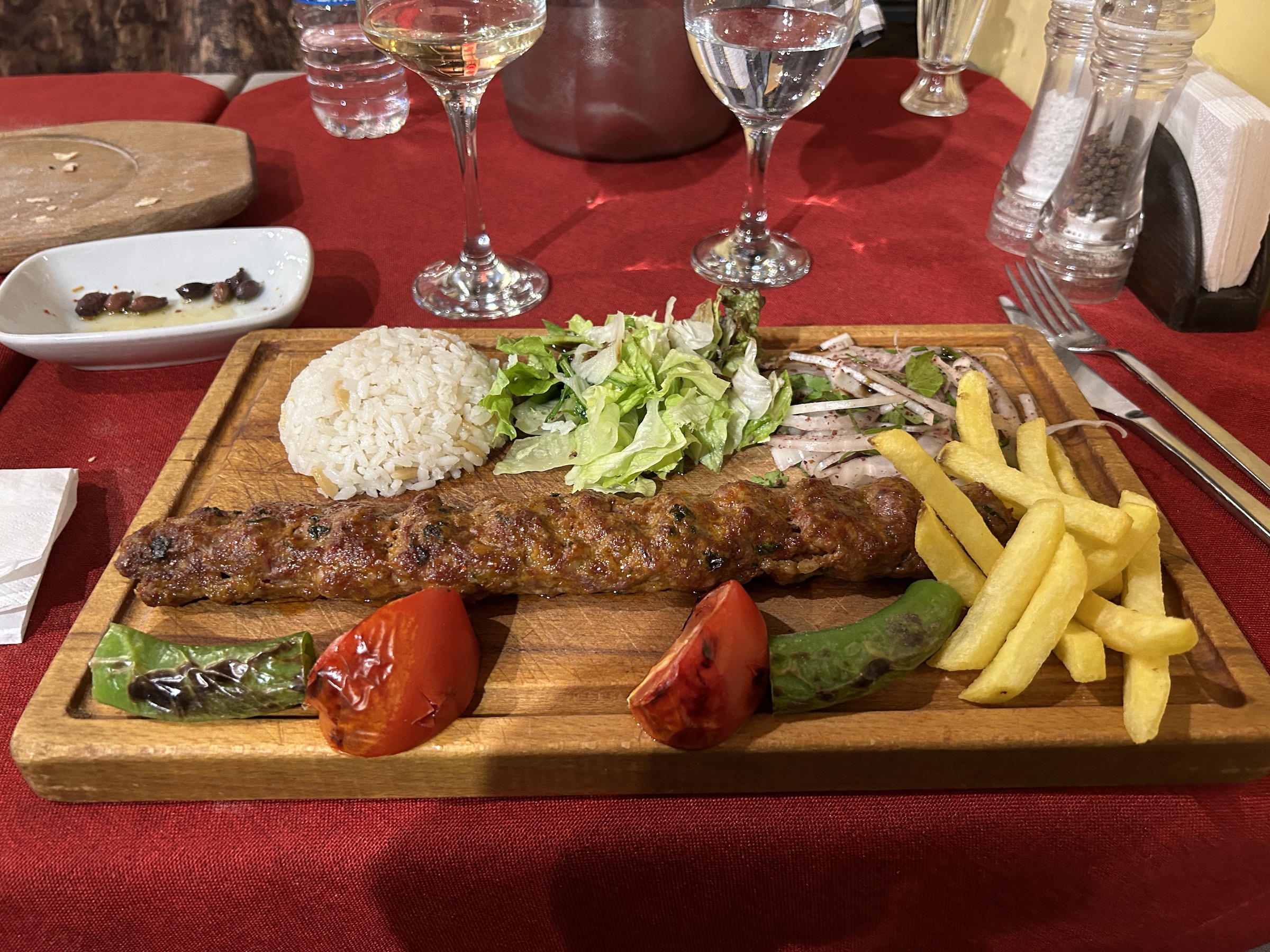
Once again we had a good chat with the owner who is as affable and hands on as he was when this place was just starting out a few years ago.
